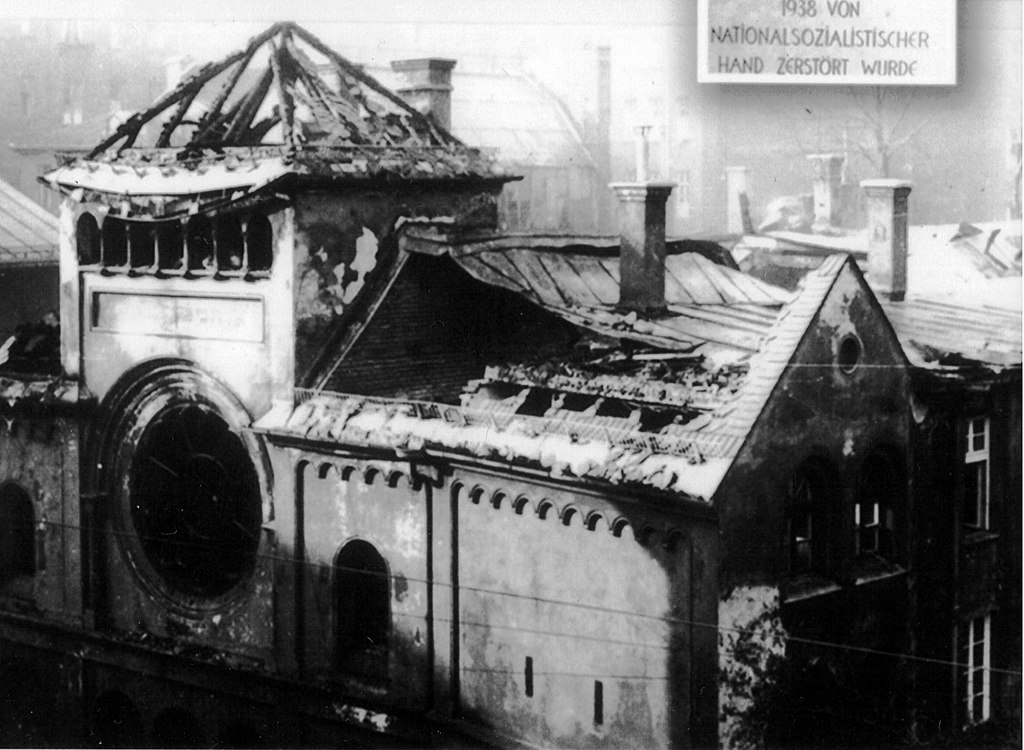Kristallnacht literally means “crystal night”. The name refers to the wave of violent anti-Jewish pogroms that occurred between the night of November 9–10, 1938 in Germany, annexed Austria, and the Sudeten areas of Czechoslovakia recently occupied by German troops.
Kristallnacht owes its name to the fragments of broken glass that covered German streets from the
windows of synagogues, houses, and Jewish businesses looted and vandalized during the violent attacks.
After the barbarism, the German government declared that these attacks had been carried out
spontaneously in response to public anger over the murder of Ernst vom Rath, an officer of the German embassy in Paris by Herschel Grynszpan, a 17-year-old Polish Jew, on November 7, 1938. It was reported that the young man carried out the murder since days before, the German authorities had expelled from the Reich thousands of Jews of Polish citizenship living in Germany, among whom were the parents
of the young man who were residents of Germany since 1911. After the expulsion Mr. Grynszpan along with other Jews had to stay in a refugee camp near the village of Zbaszyn in the border region between
Poland and Germany as they were not allowed to enter Poland.
Herschel Grynszpan was living illegally in Paris and apparently as an act of desperation and seeking revenge for his family’s precarious circumstances, he went to the German embassy and shot Ernst Vom
Rath, the diplomatic officer appointed to assist him. Vom Rath died on November 9, 1938, two days after the bombing. Coincidentally, November 9, 1923 was the date of the “Munich Putsch” or “Brewery
Putsch” failed coup attempt carried out by members of the National Socialist German Workers’ Party (NSDAP) and for which Adolf Hitler and Rudolf Hess, among other Nazi leaders, were tried and sentenced
to prison, an important day in the National Socialist calendar. The leadership of the Nazi Party, meeting in Munich for the commemoration of the “Putch”, chose to use the embassy event in Paris as a pretext to
launch a series of excessive attacks against Jews.
Propaganda Minister Joseph Goebbels, chief instigator of the pogrom, implied that “World Jewry” had conspired to carry out the murder of Vom Rath and announced that, “the Fuehrer has decided
that demonstrations should be neither prepared nor organized by the Party, but as long as they erupt spontaneously, they should not be hindered.” Goebbels’ words seem to have been taken as an order to
trigger the pogrom. After the speech, the regional Party leaders gathered there sent the message to their local offices.
Violence broke out in various parts of the Reich throughout the night and early morning of November 9-10. At twenty past one in the morning on November 10, Reinhard Heydrich, in his capacity as chief of the
Security Police (Sicherheitspolizei) sent an urgent telegram to the headquarters and local stations of the State Police and to the leaders of the SA in their various districts, to reaffirm Goebbels’ message. SA
and Hitler Youth teams participated in the destruction of Jewish homes and businesses throughout Germany and its annexed territories. Members of many of the attack teams wore civilian clothes to support the fiction that the riots were reactions of the outraged people. The central orders coming from Heydrich contained specific instructions: “spontaneous” rioters could not take action that could harm non-Jewish German people or property; they could not subject foreigners (even Jewish foreigners) to violent acts; and they had to get the archives out of synagogues before trashing them, as well as other Jewish community property. The files were to be transferred to the Security Service (Sicherheitsdienst, or SD). The orders also stated that police officers should arrest as many Jews as local jails could hold, preferably young, healthy men.
The rioters vandalized 267 synagogues and the windows of approximately 7,500 Jewish-owned commercial establishments, and looted them. Jewish cemeteries were also
desecrated throughout Germany, Austria, and the Sudetenland. Many synagogues burned all night, in full view of the public and firefighters, who had been ordered to intervene only to prevent the flames from spreading to nearby buildings belonging to non-Jews.
SS and Gestapo units under Heydrich’s instructions arrested around 30,000 Jewish men and most were
transferred to Dachau, Buchenwald, Sachsenhausen and other concentration camps. Kristallnacht marks the first instance in which the Nazi regime imprisoned Jews on a massive scale simply based on
their ethnicity. Hundreds died in the camps because of the brutal treatment they received. Most were released within the next three months on the condition that they begin the process of emigration from
Germany. In the immediate aftermath of the pogrom, many German leaders, such as Hermann Göring, criticized the extensive material losses that resulted from the antisemitic riots, pointing out that if nothing was done to intervene, German insurance companies — not Jewish-owned businesses — would bear the cost of the damages. The German government declared that Jews had been to blame for the pogrom and imposed on the German-Jewish community a punitive fine of one billion Reichsmark (about 400 million US dollars at 1938 rates).
The Reich government confiscated all indemnities paid by insurance companies from Jews whose
businesses and homes were looted or vandalized, leaving the owners responsible for the costs of all repairs. The events in Kristallnacht represented one of the most important turning points of National
Socialist antisemitic policy.
The passivity with which most German civilians responded to the violence signaled to the Nazi regime that the German public was prepared for more radical measures. The Nazi regime expanded and radicalized measures aimed at the complete elimination of Jews from German social and economic life with the policies of forced emigration, and finally toward the realization of a “Jew-free” Germany (Judenrein) through the deportation of the Jewish population “eastward.”
Kristallnacht figures as a pivotal turning point in the persecution of Jews by the Nazis, culminating in the attempt to annihilate European Jewry.
By Gina Kershenovich
